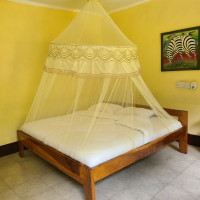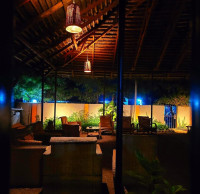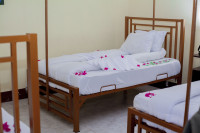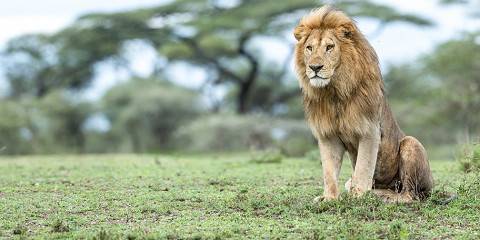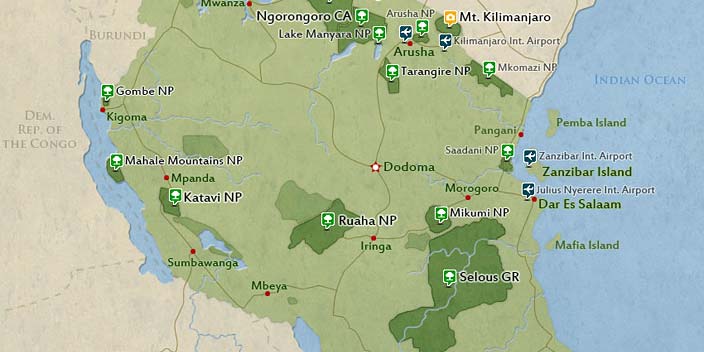
Arrival
Arrival

Day 1
Tarangire National Park
Tarangire National Park
After breakfast, you will be picked up from your accommodation in Arusha or the airport and head to Tarangire National Park in the Manyara region. The name of the park originates from the Tarangire River that crosses the park.
It is the 6th-largest national park in Tanzania and covers an area of 2,600 square kilometers. It is most popular for its large elephant herds and is usually very dry, in fact, drier than the Serengeti. However, its vegetation is much greener, with lots of grass, vast areas with mixed acacia woodlands and some of the wonderful ribbons of the aquatic forest. Don't forget about the giant baobab trees that can live up to 600 years, storing between 300 and 900 liters of water.
In the afternoon, you will break for lunch. The game drive then continues until the late afternoon. Dinner and your overnight stay will be at Fig Tree Lodge & Camp.
- Main Destination:
- Tarangire National Park
- Accommodation:
- Fig Tree Lodge
- Meals & Drinks:

Day 2
Mto wa Mbu to Serengeti
Mto wa Mbu to Serengeti
After breakfast, your guide will pick you up for a game drive with a picnic lunch. On this day, your guide will try to cover the best parts of Central and Southern Serengeti that you couldn’t cover on the first day. The morning hours are the best time to see the Big Five and predators like lions and leopards.
Serengeti is a park in northern Tanzania, a World Heritage Site covering an area of around 15,000 square kilometers. It has over 2 million herbivores, 4,000 lions, 1,000 leopards, 550 cheetahs, and some 500 bird species.
This area is filled with massive herds of migratory wildebeests and zebras during the Dry season. However, the Northern Serengeti also supports an abundance of resident wildlife including lions, elephants, hippos, giraffes, crocodiles, and the rare oribi antelopes.
- Main Destination:
- Serengeti National Park
- Accommodation:
- Budget camping
- Meals & Drinks:

Day 3
Central Serengeti
Central Serengeti
Rise early to embark on an exhilarating game drive within Serengeti National Park. Here, you can encounter wildebeest, lions, elephants, leopards, impalas, gazelles, and cheetahs and perhaps even witness the spectacular wildebeest migration. After this exciting experience, savor a delicious brunch and pack your belongings for the journey to Ngorongoro.
As you bid farewell to Serengeti, a thrilling en-route game drive awaits, ensuring your adventure continues. With the day drawing to a close, you'll reach your destination - the Ngorongoro Simba Campsite perched on the rim of the crater. Here, a warm dinner and a comfortable overnight stay await you.
- Main Destination:
- Central Serengeti National Park
- Accommodation:
- Budget camping
- Meals & Drinks:

Day 4
Ngorongoro Crater
Ngorongoro Crater
We wake up early for breakfast at 6 am and thereafter descend the Ngorongoro Crater. We will stop at the Ngorongoro viewpoint for 10 to 15 minutes to take pictures of the astonishing views of the crater and learn a short history of how it was formed.
Lunch will be served at the campsite or the "hippo pool" picnic site - a small pool in the southern part of the Ngorongoro Crater that is inhabited by a bloat of hippos. It is one of the few areas where tourists are allowed to alight from their vehicles and have a picnic or meal. Occasionally, you may also see animals come to drink from the pool.
Ngorongoro is named a “World Heritage Site” due to its astonishing wildlife experiences. It is the only crater in the world filled with abundant wildlife that spends their whole lives inside it. The crater provides up-close views of animals and is also one of the places to see Africa's Big Five.
Dinner and your overnight stay are at Fig Tree Lodge & Camp.
- Main Destination:
- Ngorongoro Crater
- Accommodation:
- Fig Tree Lodge
- Meals & Drinks:

Day 5
Lake Manyara National Park
Lake Manyara National Park
After breakfast, you will go to Lake Manyara National Park, which is famous for the large number of flamingoes in the lake and its tree-climbing lions (though they are rarely seen).
You will go on a game drive and view plenty of birds. If you are lucky, you may spot the famous tree-climbing lions. You will visit the Hippo Pool for a close look at hippos and the hot spring, all this while doing a game drive and viewing plenty of animals like buffaloes, wildebeest, warthogs, vultures, eagles, monkeys, etc.
After the tour, you will head back to your hotel in Arusha.
- Main Destination:
- Lake Manyara National Park
- Accommodation:
- No accommodation (End of tour)
- Meals & Drinks:
















